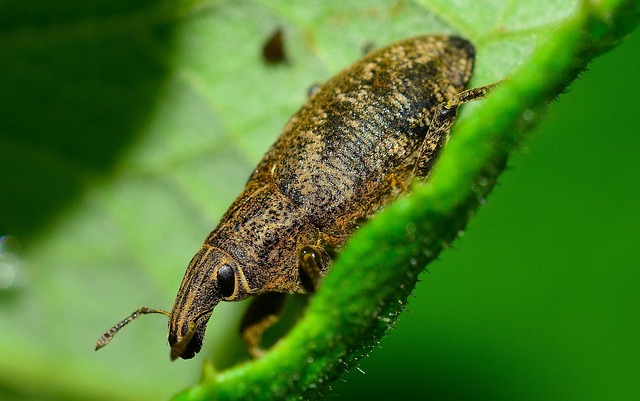Grain weevils (Sitodiniidae) are agricultural pests infesting stored grains like wheat, corn, and barley through a complete metamorphosis cycle. Understanding this cycle allows farmers to employ strategies such as airtight storage, humidity control, and regular inspections. Eco-friendly solutions, including natural predators, sanitation, pheromone traps, and sustainable farming practices, reduce chemical pesticide use. Tailored prevention plans based on local environmental conditions and proactive monitoring with advanced technologies ensure the effectiveness of eco-friendly weevil solutions while promoting ecological balance in agriculture.
Grain weevils can wreak havoc on stored grains, necessitating effective long-term prevention strategies. This article explores tailored plans for combating these pests using eco-friendly methods suitable for homes and farms. We delve into understanding grain weevil behavior and life cycles, offering practical tips for assessment and continuous monitoring. By implementing these customized, sustainable solutions, you can safeguard your valuable grains while preserving the environment. Discover how to create an impenetrable barrier against these tiny invaders with eco-friendly weevil solutions.
Understanding Grain Weevils: Behavior and Life Cycle
Grain weevils, scientifically known as Sitodiniidae, are a common agricultural pest that infests stored grains such as wheat, corn, and barley. Understanding their behavior and life cycle is crucial for developing effective eco-friendly weevil solutions. These tiny insects undergo a complete metamorphosis, starting as eggs laid within the grain kernels. After hatching, larvae emerge and feed on the grain from the inside, causing significant damage. They then pupate before transforming into adult weevils, which can fly and infest new grains.
Knowledge of their life cycle allows farmers to implement tailored prevention strategies. This includes storing grains in airtight containers, maintaining low humidity levels, and regularly inspecting crops for signs of infestation. Eco-friendly solutions may also involve the introduction of natural predators like certain bird species or beneficial insects that feed on weevils, offering a sustainable alternative to chemical pesticides.
Eco-Friendly Prevention Strategies for Home and Farms
In an effort to promote sustainable practices, eco-friendly weevil solutions are gaining traction both in homes and on farms. These strategies focus on natural methods to prevent and manage grain weevils, minimizing the reliance on chemical pesticides. One effective approach involves maintaining excellent sanitation to deprive weevils of food sources. Regularly cleaning storage areas, promptly disposing of infested grains, and sealing containers can significantly reduce weevil populations.
Another eco-friendly prevention strategy is incorporating biological controls such as beneficial insects that feed on weevils or their larvae. Using pheromone traps can also help monitor and control weevil populations by interfering with their mating patterns. Additionally, modifying storage conditions through proper ventilation and temperature control creates an environment less conducive to weevil proliferation. These organic methods not only protect crops but also contribute to a healthier ecosystem.
Customized Plans: Assessing Your Environment and Needs
When developing a customized plan for long-term prevention of grain weevils, assessing your specific environment and needs is the first step to success. This involves understanding the unique ecological factors that contribute to weevil infestations in your area, including climate patterns, local plant life, and existing pest management practices. By examining these variables, you can tailor eco-friendly weevil solutions that not only address current issues but also proactively mitigate future risks.
Customized plans should consider the entire ecosystem, from soil health to crop rotation. Using natural predators, such as certain insect species or beneficial microbes, can be highly effective in controlling weevils without resorting to chemical pesticides. Additionally, implementing sustainable farming practices like organic fertilizers and reduced water usage can create an inhospitable environment for weevils while promoting overall ecological balance.
Long-Term Implementation and Continuous Monitoring
Implementing customized, long-term prevention plans requires a dedicated and consistent approach. Once tailored strategies are in place, regular monitoring becomes crucial to ensure their effectiveness. Continuous assessment allows for immediate adjustments if any signs of weevil activity emerge, providing an adaptive framework that aligns with evolving environmental conditions. By adopting eco-friendly weevil solutions, farmers can maintain the health of their crops while minimizing the ecological impact associated with traditional pest control methods.
This monitoring process involves regular inspections, data collection, and analysis to track potential changes in weevil populations. Utilizing modern technologies such as pheromone traps and remote sensing can enhance precision and efficiency in detecting early weevil infestations. Such proactive measures not only protect crops but also contribute to the overall sustainability of agricultural practices.
Implementing customized, long-term prevention plans that integrate eco-friendly weevil solutions is key to safeguarding grains and maintaining sustainable agricultural practices. By understanding the behavior and life cycle of grain weevils, assessing specific environmental needs, and continuously monitoring effectiveness, farmers and homeowners can develop robust strategies that minimize pest damage while preserving the health of their crops and ecosystems. Adopting these tailored approaches ensures a harmonious balance between effective protection and environmentally conscious practices.
